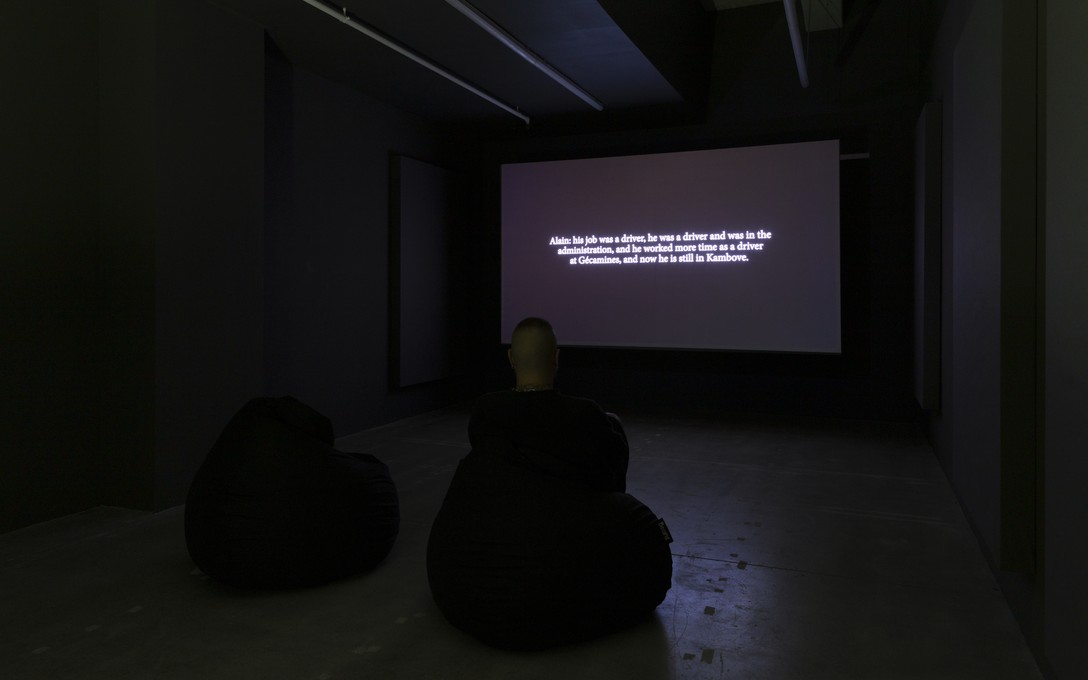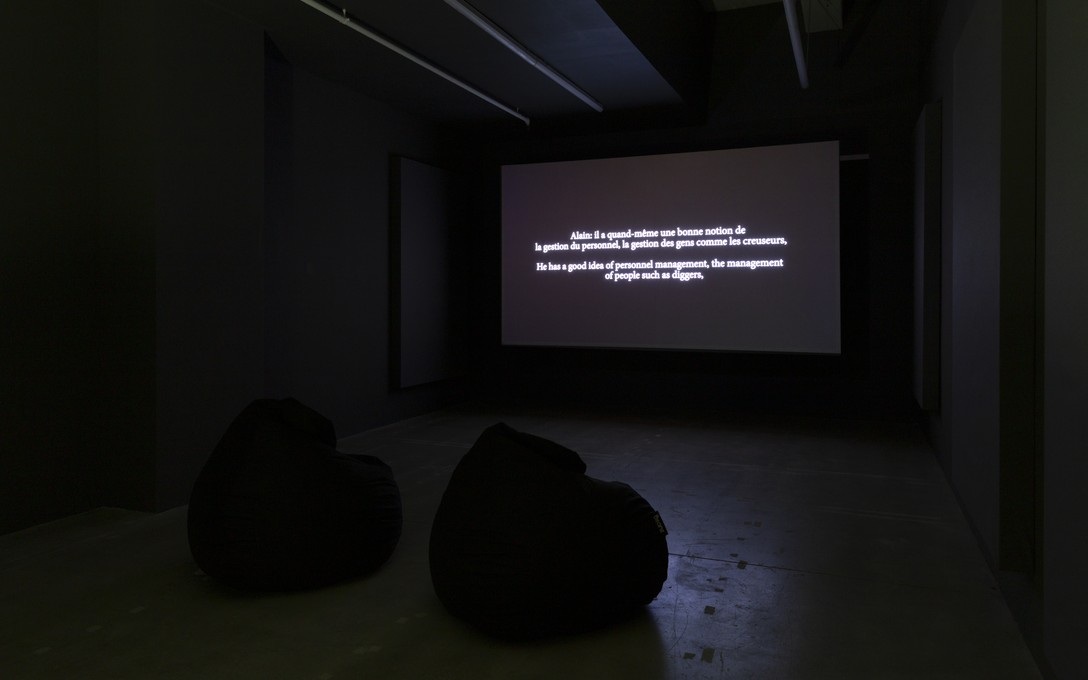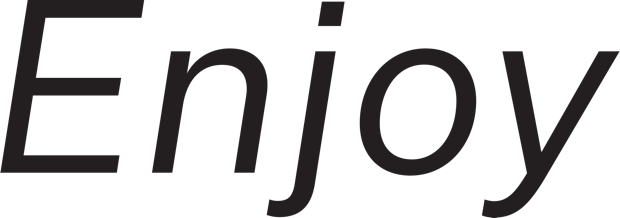The Centre Does Not Hold

Hopscotch (The Centre of the Sun's Radiance), sound installation, exhibited at After the Last Sky, de Appel, Amsterdam, 2023. Image credit: Özgür Atlagan. Courtesy of the artist.
archived
23 Mar
–
20 Apr
2024
Inas Halabi
The Centre Does Not Hold is an exhibition in three parts by the Palestinian artist Inas Halabi. Across a sound installation and two moving image works that address different regions mired in colonial power structures, Halabi considers the landscape as a living archive from which to excavate the (in)visible sediments of trauma and slow violence. In its invitation to look closely and listen deeply, The Centre Does Not Hold surveys the malleability of sound and image, and in doing so, unearths histories hiding in plain sight.
Installed at Enjoy is Hopscotch (The Centre of the Sun’s Radiance) (2021), a multi-chapter soundscape from which the exhibition takes its title. A dual-channel sound installation with video, the work takes listeners on a sonic journey across two continents—Africa and Europe—to explore how histories of labour tied to the development of the railways are embedded in the contemporary landscape. Foregrounding a kind of opacity, or a refusal of the primacy of visual representation, the work considers how sound can transform into an image. Through field recordings, oral histories and radio broadcasts, Halabi traces the extraction and transport of uranium from the Shinkolobwe uranium mine in the Democratic Republic of Congo to a former UMHK-owned* uranium refinery in Olen, Belgium. This journey across language, land and interlocutor examines how the past continues to inflect the present. Borrowing its title and structure from Julio Cortázar’s eponymous novel as well as the playground game, Hopscotch shifts between several chapters whose beginnings and endings are never the same, disrupting the notion of linear time that structures historical as well as train-based narratives. The second part of the title is taken from Patrice Lumumba’s independence speech of 1960, in which he vows to make the Democratic Republic of Congo “the centre of the sun’s radiance for Africa,” and to “keep watch over the lands of our country so that they truly profit her children,” reflecting the ongoing struggle for economic as well as political independence from colonial oppressors.
Halabi’s most recent work, the feature-length film We No Longer Prefer Mountains (2023) will be shown in a special one-night screening event on Thursday 11 April. We No Longer Prefer Mountains takes place in the remote towns of Dalyet el Carmel and Isfiya in northern Palestine, a mountainous, geographically-isolated enclave of the Druze people. Druze are a Levantine religious minority whose esoteric, ritualistic practices have been co-opted and militarised by the State of Israel. Since 1956, as a result of an obscure deal between several community leaders and political authorities, the Druze in Palestine are subject to enforced conscription in the Israeli army. Young people are sworn to military duty at the site of a significant Druze shrine, Nabi Shu'ab, transforming the ground of religious ceremony into one of nationalist fealty. Engaging with the inner politics of this deeply private community, the film weaves together intimate scenes of various protagonists in shared domestic spaces and in the landscape, reclaiming a sense of ritual in the everyday. Unscripted, the work expands into territory in which the subject controls what the camera sees. We No Longer Prefer Mountains is structurally informed by Masao Adachi’s fûkeiron (landscape) theory, a movement in Japanese avant-garde filmmaking in the late 1960s that posited that filming the landscape would reveal the forces of oppression acting upon society. In this way the land itself, and in particular Jabal al-Carmel (Mount Carmel), also becomes a protagonist of the film, a poetic gesture towards the interdependencies of all human and non-human entities that are subject to the effects and impacts of dominant political infrastructures.
Screening online at circuit.org.nz, We Have Always Known the Wind’s Direction (2019-2020) grapples with subterranean violence as it probes the possible burial of nuclear waste in the south of the West Bank in the occupied Palestinian territories. A combination of interview, conversation, and footage shot on location, the work’s documentarian impulse to catalogue the material effects of radiation (namely, the prevalence of radioactive isotope Cesium 137, a product of nuclear fission) instead hinges towards more insidious forms of representation. Fragmented conversations with a nuclear physicist and views of the landscape are uneasily underscored by what we hear, the camera’s viewfinder overlaid with a spectrum of red hues to reflect the levels of radiation found. Yet in various ways, the delivery of information is thwarted, withheld or delayed. Radioactivity, invisible but deadly, is here a metonym for a more ungraspable invisibility—the systemic networks of power and control in the region. One of the most militarised zones in the world, radioactive particles move freely through the many checkpoints and borders just outside the camera’s frame. In this context, We Have Always Known the Wind’s Direction will be shown alongside moving image works by Aotearoa artists, both allowing Halabi’s film to be seen outside of Te Whanganui-a-Tara as well as setting it in dialogue with a polyphony of practices similarly invested in the geopolitics of extractive colonialism.
*Union Minière du Haut-Katanga, a Belgian mining conglomerate that controlled and operated the (primarily copper) mining industry in parts of the Democratic Republic of the Congo between 1906 and 1966. An iteration of the corporation is now known as Umicore.
Curated by Jess Clifford
Past Event
A River Dies of Thirst
VIEW A RIVER DIES OF THIRST HERE
A River Dies of Thirst is an online screening programme that takes its name from the collection of poems, meditations, fragments, and journal entries by Palestinian poet Mahmoud Darwish, begun in the tumultuous summer of 2006, as Israel attacked Gaza and Lebanon, and published shortly before his death in 2008. Combining lyric, prose poem and aphorism, Darwish’s musings upon the unrest and loss he experiences dwell instead on love and humanity, and see the act of writing itself as an act of resistance.
More info
Inas Halabi, Hopscotch (The Centre of the Sun's Radiance), sound installation (subtitled).

Inas Halabi, Hopscotch (The Centre of the Sun's Radiance), sound installation (subtitled).

Inas Halabi, Hopscotch (The Centre of the Sun's Radiance), sound installation (subtitled).

Inas Halabi, Hopscotch (The Centre of the Sun's Radiance), sound installation. Image courtesy of Cheska Brown.

Inas Halabi, Hopscotch (The Centre of the Sun's Radiance), sound installation. Image courtesy of Cheska Brown.

Inas Halabi, Hopscotch (The Centre of the Sun's Radiance), sound installation (subtitled).

Inas Halabi, Hopscotch (The Centre of the Sun's Radiance), sound installation (subtitled).

Inas Halabi, Hopscotch (The Centre of the Sun's Radiance), sound installation. Image courtesy of Cheska Brown.

Inas Halabi, Hopscotch (The Centre of the Sun's Radiance), sound installation (subtitled).

Inas Halabi, Hopscotch (The Centre of the Sun's Radiance), sound installation. Image courtesy of Cheska Brown.

Inas Halabi, Hopscotch (The Centre of the Sun's Radiance), sound installation. Image courtesy of Cheska Brown.
CREDITS
Hopscotch (The Centre of the Sun’s Radiance), 2021
Two-channel sound installation with video
1 hour 50 mins looped
A stereo version of the work streams continuously at: www.hopscotch.film
Sound recording (DRC): Gulda Ghislain el Magambo, Alain Nsenga
Sound recording (Belgium): Aïda Merghoub, Nina de Vroome
Additional sound recording: Inas Halabi (Belgium), Judith Kalanga (DRC)
Interviewers (DRC): Gulda Ghislain el Magambo, Alain Nsenga
Interviewees & testimonies (DRC): Alain Nsenga, Papa Celestin (Mr. Ngoie Mujuka Célestin), Papa Kaba, Mama Kashala, Papa Mbuya (Mr. Etienne Mbuya Wa Banza), Papa Sylvain, Erick
Interviewers (Belgium): Nina de Vroome, Aïda Merghoub
Interviewees (Belgium): Francois Geboers, Herman Mariëns, Karel Goor, Jozef Hemeleers, Ludwig Geens
Additional voiceovers: Aïda Merghoub, Alain Nsenga, Aude Christel Mgba, Gulda Ghislain el Magambo, Inas Halabi, Nina de Vroome
Music: Deep in the Forest by Franck Moka, Deep in the River by Franck Moka, Kisangani Generation by Franck Moka, Palais Radziwill by Franck Moka, Ngongingo by Rayvanny X Baba Levo, Voyage voyage song by Desireless
Graphic design (leaflet and poster): Bardhi Haliti & Zuzana Kostelanska
Website design: Thorsten Grahl & Nelmarie du Preez
Sound design & editing: Inas Halabi
Sound mixing: Jacob Oostra
Editing consultant: Henna Hyvärinen
Editorial & production assistant: Aline Khoury
Translation (Swahili to French): Alain Nsenga, Iragi Elisha Eliya
Translation (French to english): Iragi Elisha Eliya, Nizar Halloun, Keyleen Nguyen
Translation (Flemish to English): Nina Bos
Special thanks: Alain Nsenga, Aïda Merghoub, Aline Khoury, Ateliers Picha (Lubumbashi, DRC), Caroline Dumalin, Henna Hyvärinen, Eva Giolo, Franck Moka, Lucrezia Cippitelli, Georges Senga, Gulda Ghislain el Magambo, Reem Shadid
Inas Halabi
Inas Halabi (b.1988, Palestine) is a visual artist and filmmaker. Her practice is concerned with how social and political forms of power are manifested and the impact that overlooked, or suppressed, histories have on contemporary life. She holds an MFA from Goldsmiths, University of London, and completed the De Ateliers artist residency in Amsterdam in 2019. Recent exhibitions and screenings include: Luleå Biennial, Sweden (2024); Reel Palestine Dubai (2024), TAVROS Athens (2024), Sharjah Film Platform 6, UAE (2023); Beirut Art Centre (2023); Hot Docs Canadian International Documentary Festival (2023); de Appel, Amsterdam (2023), Showroom, London (2022); Europalia Festival, Brussels (2021), Silent Green Betonhalle, Berlin (2021); Stedelijk Museum, Amsterdam (2020); and Film at Lincoln Center, USA (2020). She lives and works between Palestine and the Netherlands.
Jess Clifford
Jess Clifford is a writer, editor and curator from Te Whanganui-a-Tara Wellington, to where she has returned after several years working in art galleries and museums in London, most recently for Tate. She works for CIRCUIT Artist Moving Image and is the editor of their forthcoming survey publication. Recent curatorial projects include To the Friend Who Did Not Save My Life, Enjoy Contemporary Art Space (2023); and I’m so into you, The Physics Room (2024).
